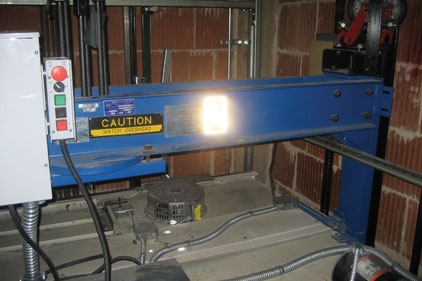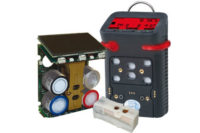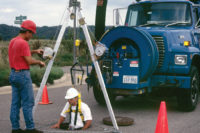“Non-classic” confined spaces
Accurate assessments are essential to safeguard occupants

Define “confined”
A confined space is one that:
(1) Is large enough and so configured that an employee can bodily enter and perform assigned work; and
(2) Has limited or restricted means for entry or exit (for example, tanks, vessels, silos, storage bins, hoppers, vaults and pits are spaces that may have limited means of entry.); and
(3) Is not designed for continuous employee occupancy.
Each of these three conditions must be met before we classify the space as a confined space. Some confined spaces may also be defined as permit-required confined spaces, which must have one or more of the following characteristics:
(1) Contains or has a potential to contain a hazardous atmosphere; or
(2) Contains a material that has the potential for engulfing an entrant; or
(3) Has an internal configuration such that an entrant could be trapped or asphyxiated by inwardly converging walls or by a floor which slopes downward and tapers to a smaller cross-section; or
(4) Contains any other recognized serious safety or health hazard.
Assessing elevator area hazards
Most of us would agree that the elevator pit area below the car meets the definition of a confined space because it meets all three confined space requirements. This area also meets two of the permit-required characteristics, i.e. “contains or has the potential to contain a hazardous atmosphere” and “contains any other recognized serious safety or health hazard.”
The first confined space permit issue is that below-grade areas like pits could accumulate heavier-than-air toxic gasses, so these areas need to be monitored closely. These below-grade pits could slowly accumulate heavier-than-air toxic gasses over time, so initial monitoring is necessary
Another important point to remember is that hazards could not only be initially present but could also be introduced into the space because of the work taking place in or near the confined space.
An example is when welding is done in the shaft-way and areas below-grade like an elevator pit, which could accumulate these heavier-than-air off-gasses. This elevator pit meets the definition of a confined space and the off gasses would make the pit a permit-required confined space. Welding in a confined space could drastically reduce the oxygen content as well as increase carbon dioxide and other toxic gasses. With this information, it’s understandable to evaluate this space and post signs advising that this area is a permit-required space.
But have we considered the area above the car? This elevated area may not be affected the same as areas below the car because of the density of these heavier-than-air gasses. It will take longer for the heavier-than-air toxic gasses to accumulate above the car than below the car. Obviously other factors like the length of weld time, the depth of the pit, forced circulation and passive circulation all influence gas accumulation.
According to OSHA CFR 1910.146(c)(2): If the workplace contains permit spaces, the employer shall inform exposed employees, by posting danger signs or by any other equally effective means, of the existence and location of and the danger posed by the permit spaces.
NOTE: A sign reading DANGER—PERMIT-REQUIRED CONFINED SPACE, DO NOT ENTER or using other similar language would satisfy the requirement for a sign.
However, the area above the car may not have a restricted means for entry or exit and therefore may not meet the definition of a confined space. Getting onto the roof of the car is usually done from the floor above by stepping horizontally with no restrictions from an open doorway onto the roof of the car. Therefore, the space above the car does not meet the definition of a confined space. Therein lies a problem. The shaft-way is both a permit required space as well as not a confined space.
If we sign the shaft-way as a permit required confined space, we do not account for the area above the car. The area above the car has a different set of characteristics than below the car. Any posted sign could be confusing and misleading. It’s important to understand the hazards and classification of the space to accurately address the safeguards we need to implement.
Remember, area classification is determined prior to the start of work, and any subsequent work may change this classification. So we have the location that may be classified differently in one part of the shaft-way vs. another, and the work to be done may also change this classification. Even though an area may not be classified as a confined space, it may still contain serious hazards that need to be addressed. For instance, the area above the car may require fall protection even though it’s not a confined space, while the area below the car may require more air monitoring and bracing.
The second confined space permit issue is the weight of the elevator car. This suspended car represents a recognized serious safety or health hazard. If work must be done under the car, a thorough safety review outlining the safeguards must be documented first.
So what does this mean?
Shaft-ways may have different space classifications depending on location and may change classifications depending on the work to be performed. Any posted sign may not be accurate so caution must prevail. When work is to be done in a shaft-way, additional resources should be brought in to help make an accurate assessment of the necessary safety precautions.
A thorough evaluation
In summary, there may be differences in confined space classification based on the differences above the car and below the car. Appropriate signage for one area of an elevator shaft-way may not be accurate for another area. An incorrect sign could contribute to a safety incident. The signage may not accurately describe the entire space or the work that might also change this space classification. Even if the area does not meet the definition of a confined space, adequate precautions still need to be taken.
The point of this discussion is not to resolve all situations, but rather to encourage confined space rationale in non-classic spaces. Confined spaces like shaft-ways may have different classifications depending on location and may also change with the work to be done. Whenever work is to be done in these locations, a reevaluation by the appropriate resources is always recommended.
Looking for a reprint of this article?
From high-res PDFs to custom plaques, order your copy today!








